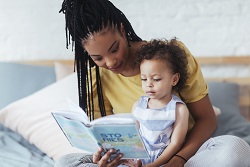Reading with a child is one of the most basic ways to promote literacy.
It also helps create a strong parent-child connection, can act as a transition to bed time, and can create a life-long love of books and reading.
But these days, parents not only have to choose what book to read, they also have to decide between using a print book or a digital e-book.
There was a small study done in March 2019 that compared these two methods of reading to children.
They looked at 37 parent-child dyads. (The study was not big enough to draw conclusions from but enough to encourage parents to think beyond the convenience factor of e-books.)
The study found that parents and children interacted less with e-books. They also verbalized less.
When parents read print books, they tend to talk more frequently with their children and the “quality” of their interactions is higher.
 What do we mean by “interactions?”
What do we mean by “interactions?”
An example of a reading interaction would be when a parent points to a picture in the story and says to their young child, “what does a cow say?” or, “what is happening here?” Or, it may be a parent pausing from the story to relate the content to something that has happened with the child. For example, “Johnny went to the beach with his family. Remember when we did that?”
These types of interactions are important literacy and language builders.
The other noted behavior difference was that when parents used e-books that used “enhanced” features–such as sound effects and animation–the parents talked less about the story with their child and more about the technology itself. And the talk about the technology was mostly disciplinary (don’t push that button, don’t change the volume!)
The take away
Parent-led conversation as a component of reading with a child is an important part of developing language and literacy skills. If you choose to use e-books with your child, try to engage with them the way you would with a print book.
And whichever type of book you choose, non-verbal interactions during reading (snuggling, enthusiasm) go a long way in creating a love of reading for a child.

